TOYOTA RAV4 1999 Owners Manual
Manufacturer: TOYOTA, Model Year: 1999, Model line: RAV4, Model: TOYOTA RAV4 1999Pages: 226, PDF Size: 3.89 MB
Page 201 of 226
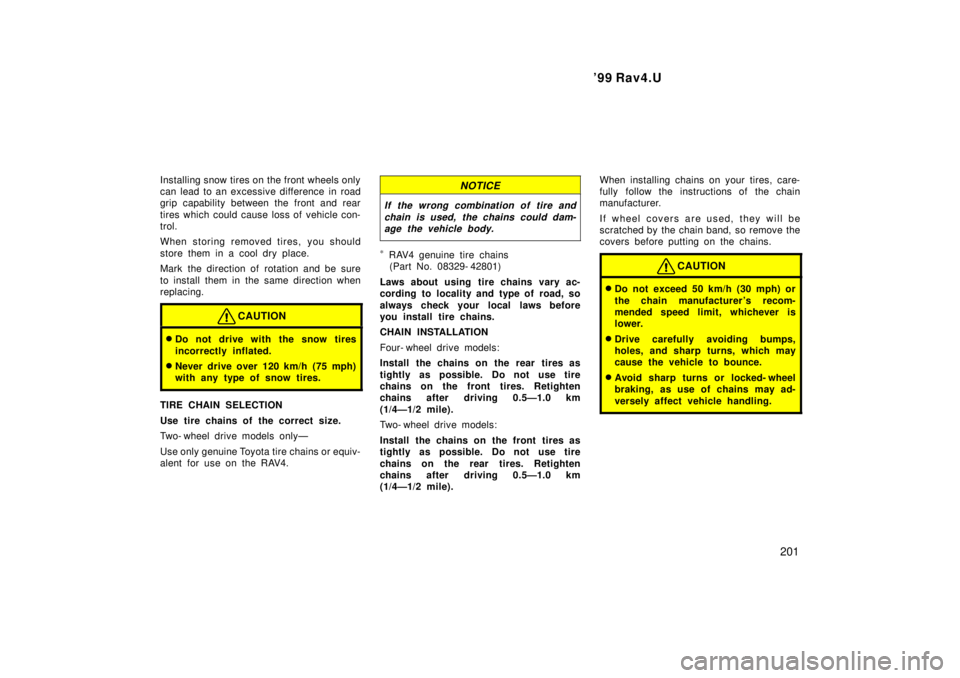
'99 Rav4.U201
Installing snow tires on the front w
heels only
can lead to an excessive difference in road
grip capab ility between the front and rear
tires which could cause loss of vehicle con-
trol.
When storing removed tires, you should
store them in a cool dry place.
Mark the direction of rotation and be sure
to install them in the same direction when
replacing.
CAUTION
� Do not drive with the snow tires
incorrectly inflated.
� Never drive over 120 km/h (75 mph)
with any type of snow tires.
TIRE CHAIN SELECTION
Use tire chains of the correct size.
Two- wheel drive models onlyÐ
Use only genuine Toyota tire chains or equiv-
alent for use on the RAV4.
NOTICE
If the wrong combination of tire and
chain is used, the chains could dam-age the vehicle body.
* RAV4 genuine tire chains
(Part No. 08329- 42801)
Laws about using tire chains vary ac-
cording to locality and type of road, so
always check your local laws before
you install tire chains.
CHAIN INSTALLATION
Four- wheel drive models:
Install the chains on the rear tires as
tightly as possible. Do not use tire
chains on the front tires. Retighten
chains after driving 0.5Ð1.0 km
(1/4Ð1/2 mile).
Two- wheel drive models:
Install the chains on the front tires as
tightly as possible. Do not use tire
chains on the rear tires. Retighten
chains after driving 0.5Ð1.0 km
(1/4Ð1/2 mile). When installing chains on your tires, care-
fully follow the instructions of the chain
manufacturer.
If wheel covers are used, they will be
scratched by the chain band, so remove the
covers before putting on the chains.
CAUTION
�
Do not exceed 50 km/h (30 mph) or
the chain manufacturer 's recom-
mended speed limit, whichever is
lower.
� Drive carefully avoiding bumps,
holes, and sharp turns, which may
cause the vehicle to bounce.
� Avoid sharp turns or locked- wheel
braking, as use of chains may ad-
versely affect vehicle handling.
Page 202 of 226
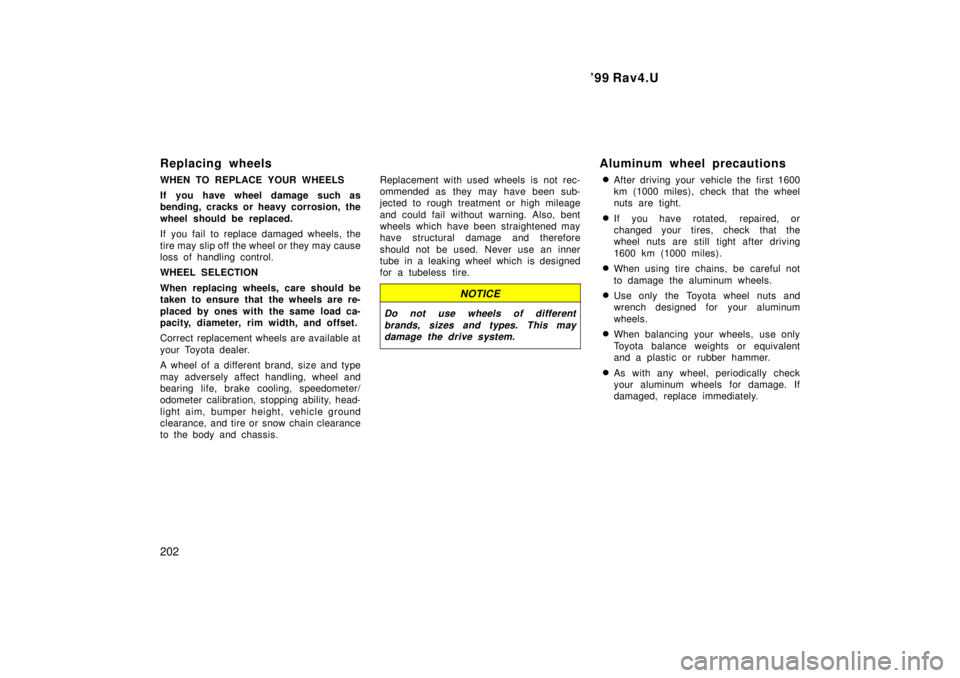
'99 Rav4.U
202
Replacing wheels
WHEN TO REPLACE YOUR WHEELS
If you have wheel damage such as
bending, cracks or heavy corrosion, the
wheel should be replaced.
If you fail to replace damaged wheels, the
tire may slip off the wheel or they may cause
loss of handling control.
WHEEL SELECTION
When replacing wheels, care should be
taken to ensure that the wheels are re-
placed by ones with the same load ca-
pacity, diameter, rim width, and offset.
Correct replacement wheels are available at
your Toyota dealer.
A wheel of a different brand, size and type
may adversely affect handling, wheel and
bearing life, brake cooling, speedometer/
odometer calibration, stopping ab
ility, head-
light aim, bumper height, vehicle ground
clearance, and tire or snow chain clearance
to the body and chassis. Replacement with used wheels is not rec-
ommended as they may have been sub-
jected to rough treatment or high mileage
and could fail without warning. Also, bent
wheels which have been straightened may
have structural damage and therefore
should not be used. Never use an inner
tube in a leaking wheel which is designed
for a tubeless tire.
NOTICE
Do not use wheels of different
brands, sizes and types. This maydamage the drive system.
Aluminum wheel precautions
� After driving your vehicle the first 1600
km (1000 miles), check that the wheel
nuts are tight.
� If you have rotated, repaired, or
changed your tires, check that the
wheel nuts are still tight after driving
1600 km (1000 miles).
� When using tire chains, be careful not
to damage the aluminum wheels.
� Use only the Toyota wheel nuts and
wrench designed for your aluminum
wheels.
� When balancing your wheels, use only
Toyota balance weights or equivalent
and a plastic or rubber hammer.
� As with any wheel, periodically check
your aluminum wheels for damage. If
damaged, replace immediately.
Page 203 of 226
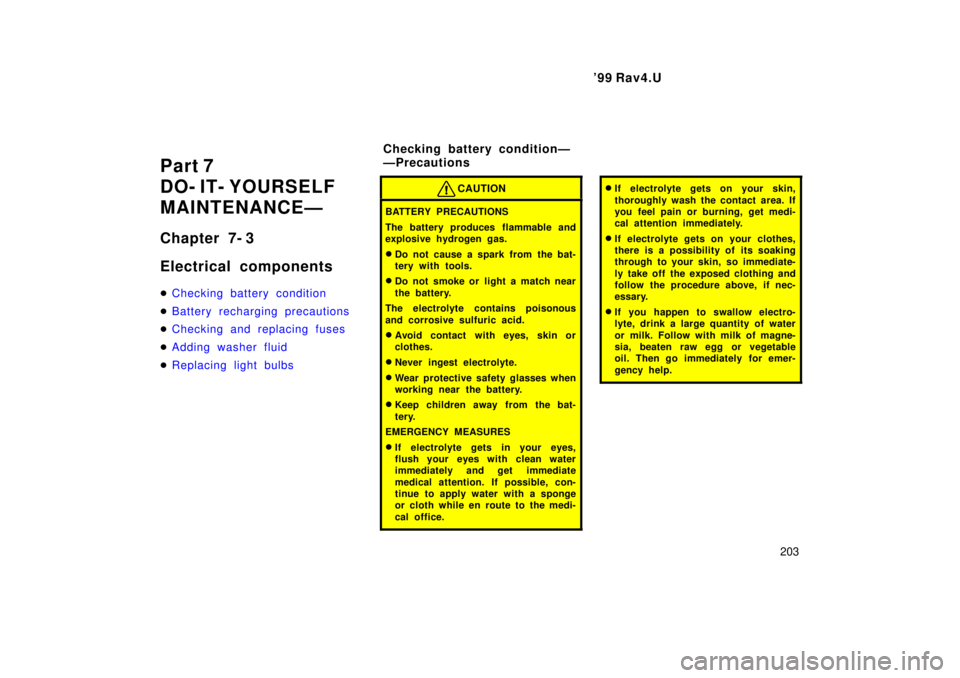
'99 Rav4.U203
Part 7
DO- IT- YOURSELF
MAINTENANCEÐ
Chapter 7- 3
Electrical components �
Checking battery condition
�Battery recharging precautions
�Checking and replacing fuses
�Adding washer fluid
�Replacing light bulbs
CAUTION
BATTERY PRECAUTIONS
The battery produces flammable and
explosive hydrogen gas. �
Do not cause a spark from the bat-
tery with tools.
� Do not smoke or light a match near
the battery.
The electrolyte contains poisonous
and corrosive sulfuric acid. � Avoid contact with eyes, skin or
clothes.
� Never ingest electrolyte.
� Wear protective safety glasses when
working near the battery.
� Keep children away from the bat-
tery.
EMERGENCY MEASURES � If electrolyte gets in your eyes,
flush your eyes with clean water
immediately and get immediate
medical attention. If possible, con-
tinue to apply water with a sponge
or cloth while en route to the medi-
cal office.
�If electrolyte gets on your skin,
thoroughly wash the contact area. If
you feel pain or burning, get medi-
cal attention immediately.
� If electrolyte gets on your clothes,
there is a possibility of its soaking
through to your skin, so immediate-
ly take off the exposed clothing and
follow the procedure above, if nec-
essary.
� If you happen to swallow electro-
lyte, drink a large quantity of water
or milk. Follow with milk of magne-
sia, beaten raw egg or vegetable
oil. Then go immediately for emer-
gency help.
Checking battery c onditionÐ
ÐPrecautions
Page 204 of 226
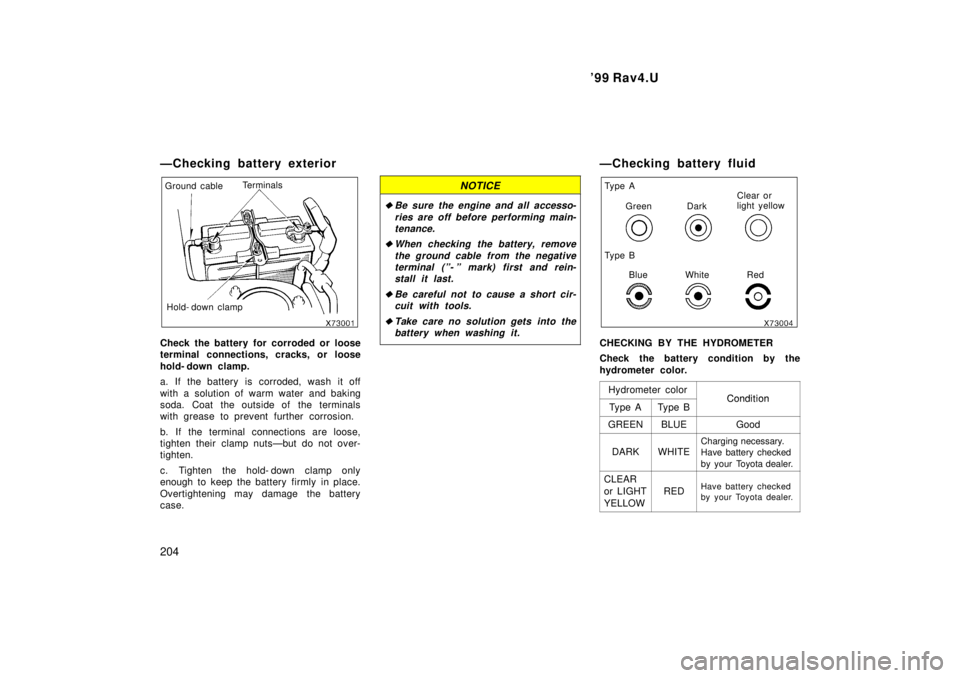
'99 Rav4.U
204
ÐChecking battery exterior
Ground cable
Terminals
Hold- down clamp
Check the battery for corroded or loose
terminal connections, cracks, or loose
hold- down clamp.
a. If the battery is corroded, wash it off
with a solution of warm water and baking
soda. Coat the outside of the terminals
with grease to prevent further corrosion.
b. If the terminal connections are loose,
tighten their clamp nutsÐbut do not over-
tighten.
c. Tighten the hold- down clamp only
enough to keep the battery firmly in place.
Overtightening may damage the battery
case.NOTICE
�Be sure the engine and all accesso- ries are off before performing main-tenance.
�When checking the battery, remove
the ground cable from the negativeterminal (º- º mark) first and rein-stall it last.
�Be careful not to cause a short cir- cuit with tools.
�Take care no solution gets into thebattery when washing it.
ÐChecking battery fluid
Green
Ty p e A
Dark
White Clear or
light yellow
Ty p e B Blue Red
CHECKING BY THE HYDROMETER
Check the battery condition by the
hydrometer color. Hydrometer color
ConditionTy p e ATy p e BCondition
GREENBLUEGood
DARKWHITECharging necessary. Have battery checked
by your Toyota dealer.
CLEAR
or LIGHTYELLOW
REDHave battery checked
by your Toyota dealer.
Page 205 of 226
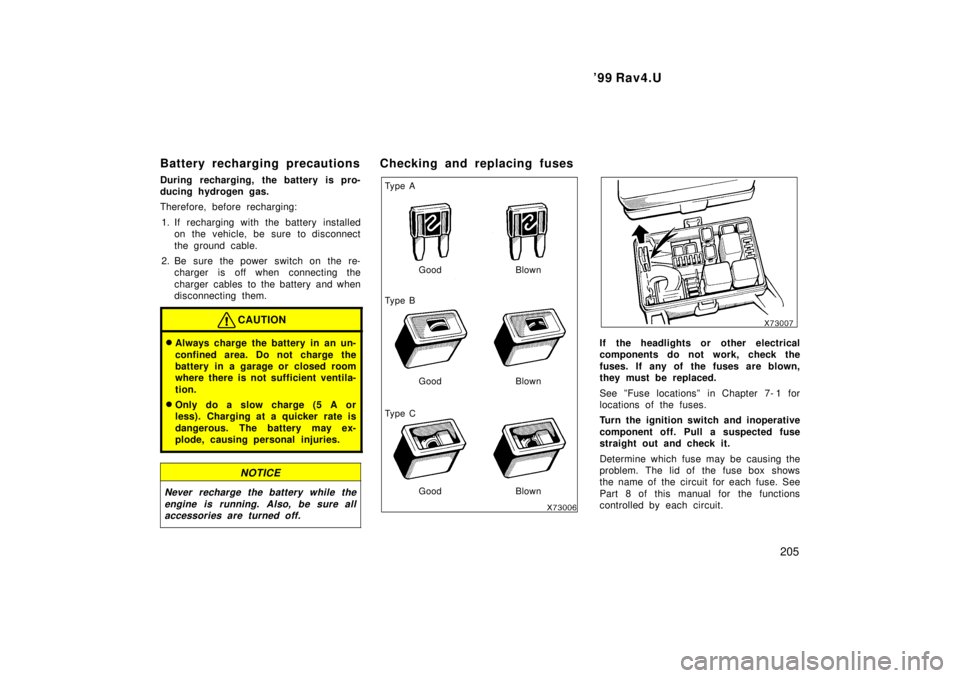
'99 Rav4.U205
Battery recharging precautions
During recharging, the battery is pro-
ducing hydrogen gas.
Therefore, before recharging:
1. If recharging with the battery installed on the vehicle, be sure to disconnect
the ground cable.
2. Be sure the power switch on the re- charger is off when connecting the
charger cables to the battery and when
disconnecting them.
CAUTION
�Always charge the battery in an un-
confined area. Do not charge the
battery in a garage or closed room
where there is not sufficient ventila-
tion.
� Only do a slow charge (5 A or
less). Charging at a quicker rate is
dangerous. The battery may ex-
plode, causing personal injuries.
NOTICE
Never recharge the battery while the
engine is running. Also, be sure allaccessories are turned off.
Checking and replacing fuses
Ty p e A
Good Blown
Ty p e B
Good Blown
Ty p e C
Good Blown
If the headlights or other electrical
components do not work, check the
fuses. If any of the fuses are blown,
they must be replaced.
See ºFuse locationsº in Chapter 7- 1 for
locations of the fuses.
Turn the ignition switch and inoperative
component off. Pull a suspected fuse
straight out and check it.
Determine which fuse may be causing the
problem. The lid of the fuse box shows
the name of the circuit for each fuse. See
Part 8 of this manual for the functions
controlled by each circuit.
Page 206 of 226
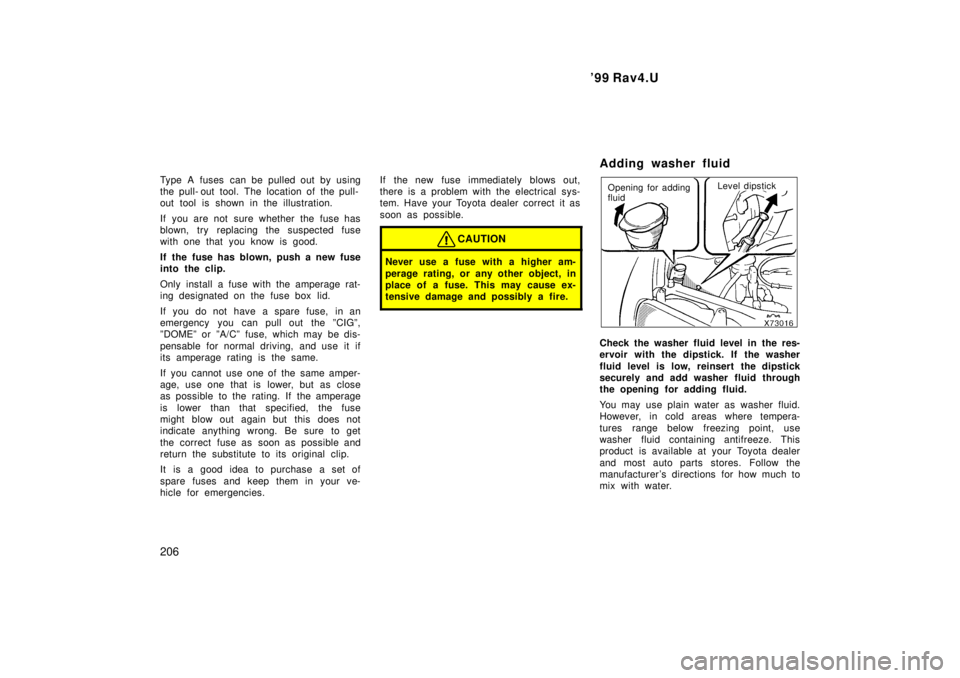
'99 Rav4.U
206
Type A fuses can be pulled out by using
the pull- out tool. The location of the pull-
out tool is shown in the illustration.
If you are not sure whether the fuse has
blown, try replacing the suspected fuse
with one that you know is good.
If the fuse has blown, push a new fuse
into the clip.
Only install a fuse with the amperage rat-
ing designated on the fuse box lid.
If you do not have a spare fuse, in an
emergency you can pull out the ºCIGº,
ºDOMEº or ºA/Cº fuse, which may be dis-
pensable for normal driving, and use it if
its amperage rating is the same.
If you cannot use one of the same amper-
age, use one that is lower, but as close
as possible to the rating. If the amperage
is lower than that specified, the fuse
might blow out again but this does not
indicate anything wrong. Be sure to get
the correct fuse as soon as possible and
return the substitute to its original clip.
It is a good idea to purchase a set of
spare fuses and keep them in your ve-
hicle for emergencies.
If the new fuse immediately blows out,
there is a problem with the electrical sys-
tem. Have your Toyota dealer correct it as
soon as possible.
CAUTION
Never use a fuse with a higher am-
perage rating, or any other object, in
place of a fuse. This may cause ex-
tensive damage and possibly a fire.
Adding washer fluid
Opening for adding
fluid
Level dipstick
Check the washer fluid level in the res-
ervoir with the dipstick. If the washer
fluid level is low, reinsert the dipstick
securely and add washer fluid through
the opening for adding fluid.
You may use plain water as washer fluid.
However, in cold areas where tempera-
tures range below freezing point, use
washer fluid containing antifreeze. This
product is available at your Toyota dealer
and most auto parts stores. Follow the
manufacturer 's directions for how much to
mix with water.
Page 207 of 226
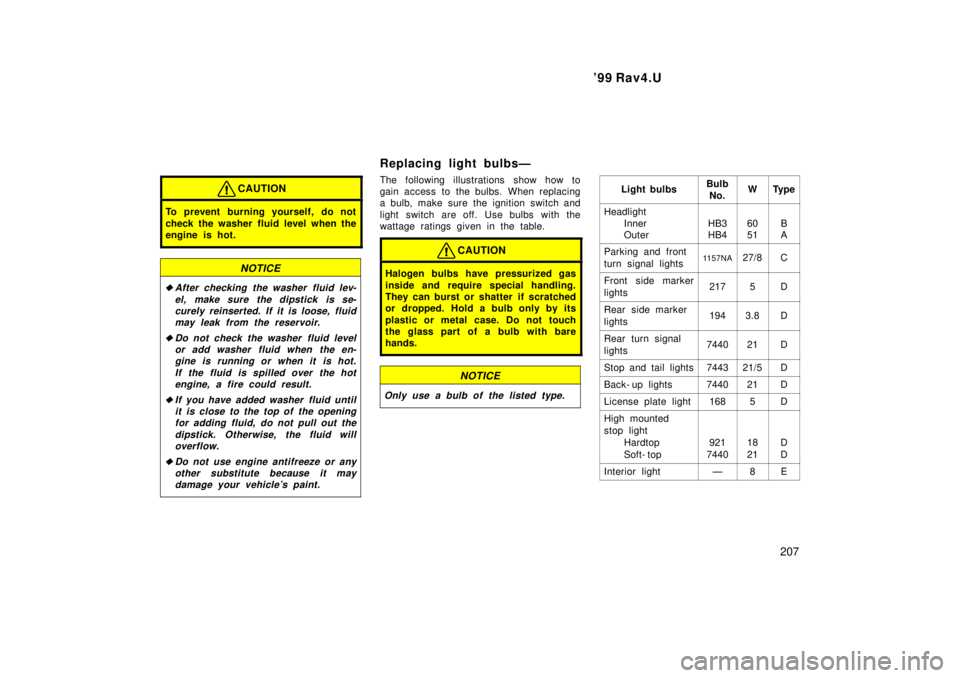
'99 Rav4.U207
CAUTION
To prevent burning yourself, do not
check the washer fluid level when the
engine is hot.
NOTICE
�After checking the washer fluid lev-el, make sure the dipstick is se-curely reinserted. If it is loose, fluid may leak from the reservoir.
�Do not check the washer fluid levelor add washer fluid when the en- gine is running or when it is hot.
If the fluid is spilled over the hotengine, a fire could result.
�If you have added washer fluid untilit is close to the top of the opening for adding fluid, do not pull out the
dipstick. Otherwise, the fluid willoverflow.
�Do not use engine antifreeze or any
other substitute because it may damage your vehicle's paint.
Replacing light bulbsÐ
The following illustrations show how to
gain access to the bulbs. When replacing
a bulb, make sure the ignition switch and
light switch are off. Use bulbs with the
wattage ratings given in the table.
CAUTION
Halogen bulbs have pressurized gas
inside and require special handling.
They can burst or shatter if scratched
or dropped. Hold a bulb only by its
plastic or metal case. Do not touch
the glass part of a bulb with barehands.
NOTICE
Only use a bulb of the listed type.
Light bulbsBulb
No.WTy p e
Headlight Inner
Outer
HB3 HB460 51B A
Parking and front
turn signal lights1157NA27/8C
Front side marker
lights2175D
Rear side marker
lights1943.8D
Rear turn signal
lights744021D
Stop and tail lights744321/5D
Back- up lights744021D
License plate light1685D
High mounted
stop light
Hardtop
Soft- top
921
744018 21D D
Interior lightÐ8E
Page 208 of 226

'99 Rav4.U
208 Light bulbs
Bulb
No.WTy p e
Personal light
(with moon roof)Ð10C
Personal lights
(without moon
roof)
Ð8C
A: HB4 halogen bulbs
B: HB3 halogen bulbs
C: Single end bulbs
D: Wedge base bulbs
E: Double end bulbs ÐHeadlights
1. Open the hood. Unplug the connec-
tor while depressing the lock re-
lease.
If the connector is tight, wiggle it.2. Turn the bulb and remove it.
Page 209 of 226

'99 Rav4.U209
3. Install a new bulb and the connectorinto the mounting hole.
Aiming is not necessary after replacing
the bulb. When aiming adjustment is nec-
essary, contact your Toyota dealer.Use a Phillips- head screwdriver.a: Front side marker light
b: Parking and front turn signal light
ÐParking, front turn signal
and front side marker lights
Page 210 of 226

'99 Rav4.U
210
ÐRear side marker lights
Use a Phillips- head screwdriver.Use a Phillips- head screwdriver.
ÐRear turn signal, stop and
tail, and back- up lights